50 Fast Growing Trees (With Pictures) – Identification Guide

Fast-growing trees for your garden landscape are ideal for shade and privacy. Planting trees with a fast growth rate means they reach their mature height in a relatively short time. This gives you the opportunity to achieve your landscaping goals sooner. Additionally, fast-growing evergreen trees have the advantage of offering privacy throughout the year.
Some of the most popular fast-growing trees for shade are maple, birch, weeping willow, and flowering dogwood trees. However, suppose you need evergreen trees with accelerated growth for privacy or screening. In that case, arborvitae, cypress, and white pine trees are ideal choices. These evergreen varieties have dense foliage and grow rapidly.
What are the fastest-growing trees for privacy and shade in your garden? This article has descriptions and pictures of trees with the best growth rates for residential landscapes.
Fast-Growing Trees (With Pictures)
Fast-growing trees are great options for adding height, structure, and texture to your garden landscape. Due to their spreading canopies or dense foliage, they also are ideal for protecting your property from sunlight, prying eyes, noise, or wind. Please read on to learn about trees with a fast growth rate.
Red Maple (Acer Rubrum)
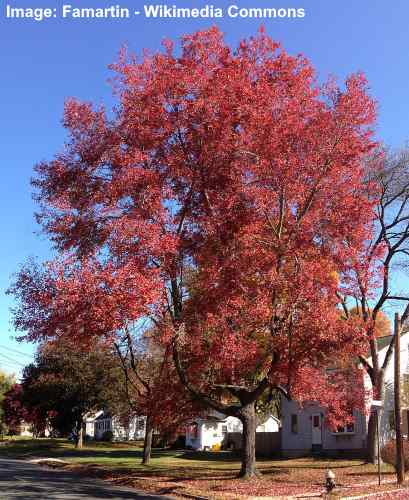
The fast growing red maple tree has a spectacular autumn foliage and looks great in any landscaped garden
The red maple is a fast-growing shade tree with an open growth habit and dense foliage. Characteristics of red maples are their reddish spring flowers, spectacular yellow and red fall foliage, winged V-shaped papery seed cases, and attractive gray bark. It’s suitable for growing in USDA zones 3 to 9.
The red maple grows between 40 and 120 ft. (12 – 36 m) tall and up to 50 ft. (15 m) wide. The red maple is an excellent choice as a shade tree in areas where it receives full sun exposure during the summer months.
The outstanding feature of the fast-growing red maple is its three to five lobed leaves with serrated margins. The showy deltoid leaves are green during summer, helping to provide shade in gardens thanks to dense foliage. In the fall, the leaves turn golden yellow and bright red.
- USDA Hardiness Zone: 3 to 9
- Sun Exposure: Full sun
- Growth Rate per Year: Approximately 2 to 3 feet (0.6 to 0.9 meters)
- Mature Height: Between 40 and 120 feet (12 to 36 meters)
Freeman Maple (Acer x freemanii ‘Autumn Blaze’)
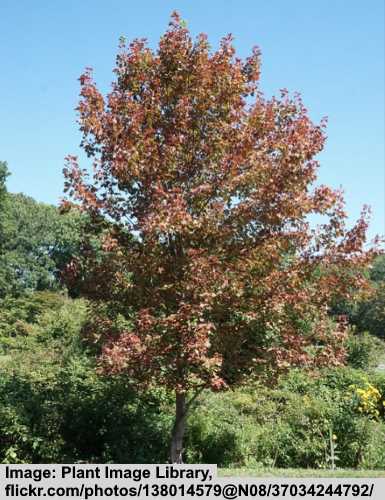
Freeman maple tree has fast growth rate and includes many cultivars
The Freeman maple is a medium-sized shade tree with a rapid growth habit. Its dense, rounded crown makes it a good option for sheltering a garden from the sun during summer. In addition, this hybrid maple has an excellent form and spectacular fall color — bright orange to red foliage.
The Freeman maple grows 45 to 70 ft. (14 – 21 m) tall and 35 to 50 ft. (10 – 15 m) wide. You can plant this maple shade tree in USDA zones 3 through 8 in full sun and moist, well-drained soil.
Other distinctive features of this fast-growing maple tree include its dense clusters of red flowers, five-lobed leaves that turn from green to red in the fall, and smooth gray bark.
- USDA Hardiness Zone: 3 to 8
- Sun Exposure: Full sun
- Growth Rate per Year: Moderate to fast growth
- Mature Height: Between 45 and 70 feet (14 to 21 meters)
Silver Maple (Acer saccharinum)
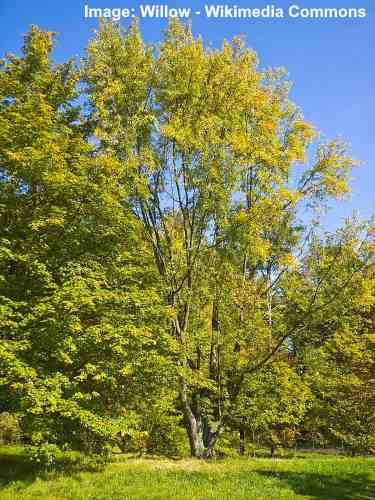
The silver maple is a fast growing deciduous shade tree with silver-green leaves
The silver maple is an impressive shade tree characterized by the silvery underside of its leaves. With its dense canopy, this large shade-providing tree has shaggy brown bark, lobed silver-green leaves, and small papery winged samaras (fruits). Although this maple blooms in spring, its reddish flower clusters are insignificant.
The silver maple is a fast-growing tree with a spreading oval shape — ideal for protecting a backyard from sunlight. This deciduous shade tree reaches heights of 50 to 80 ft. (15 – 24 m) and up to 50 ft. (15 m) wide. Grow the tree in USDA zones 3 to 9.
Also called creek maple, silverleaf maple, white maple, and swamp maple, this fast-growing deciduous tree is ideal for providing shade in a garden. It’s also tolerant of heat, poor soil, and drought.
- USDA Hardiness Zone: 3 to 9
- Sun Exposure: Full sun
- Growth Rate per Year: Approximately 2 to 3 feet (0.6 to 0.9 meters)
- Mature Height: Between 50 and 80 feet (15 to 24 meters)
Sawtooth Oak (Quercus Acutissima)
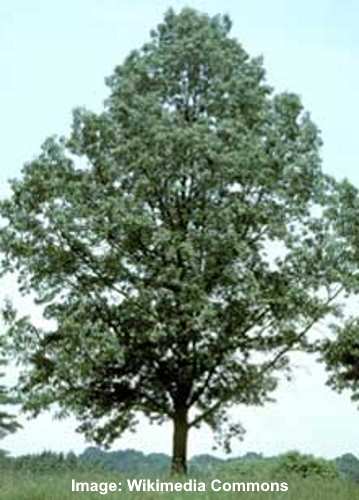
Sawtooth oak trees have moderate to fast growth rate and are good shade trees
The sawtooth oak is a moderate to fast grower tree with a wide, spreading crown making it perfect for shading a backyard. This medium-sized tree has a broad, pyramidal crown with lustrous green leaves, yellowish-green flower clusters, and coppery-brown fall colors. Sawtooth oaks grow 30 to 75 ft. (9 – 22 m) tall.
Its broad-spreading, oval to conical crown make the sawtooth oak ideal for shade in garden landscapes. The canopy measures up to 60 ft. (18 m) wide. This shade canopy consists of bristle-toothed leaves that turn golden brown and persist into winter.
Sawtooth oaks are ideal for growing in USDA zones 5 through 8 and perform well in full sun and well-drained soils. Once established, this oak tree species is tolerant of drought, heat, and humidity.
- USDA Hardiness Zone: 5 to 8
- Sun Exposure: Full sun
- Growth Rate per Year: Moderate to fast growth
- Mature Height: Between 30 and 75 feet (9 to 22 meters)
River Birch (Betula nigra)
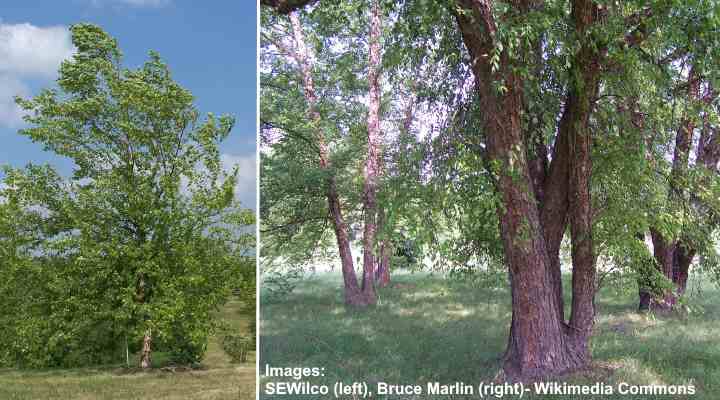
The river birch is a low maintenance tree with rapid growth rate and tolerance for wet soil
The river birch is a deciduous multi-stemmed tree that works well as a shade or screening tree when grouped together. This common tree has rapid growth and features diamond-shaped glossy green leaves forming a pyramidal crown. In addition to being a great choice for shade, river birch also produces dangling yellowish-brown catkins in groups of three.
River birch trees tend to grow in clumps and can reach heights of 30 to 70 ft. (9 – 21 m) and up to 60 ft. (18 m) wide. It is suitable for growing in USDA zones 4 through 9, making this suitable as a fast growing shade tree in northern Florida.
Besides being useful as a shade tree, a river birch has great ornamental value. It has silvery white exfoliating bark, and golden yellow fall colors provide year-long visual interest. Additionally, it requires little maintenance. It also tolerates moist, soggy soils and full sun.
- USDA Hardiness Zone: 4 to 9
- Sun Exposure: Full sun to partial shade
- Growth Rate per Year: Rapid growth
- Mature Height: Between 30 and 70 feet (9 to 21 meters)
Crape Myrtle Tree (Lagerstroemia indica)
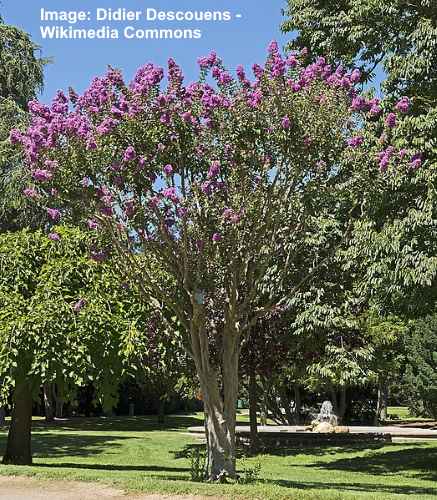
Crape myrtle trees have spectacular clusters of flowers and are known for their rapid growth
Crape myrtle is a beautiful flowering tree for providing shade in southern garden landscapes. The deciduous tree is known for its rapid growth, abundance of bright pink flowers, exfoliating bark, and leathery, glossy green oblong leaves. Crape myrtle also has spectacular orange, gold, yellow, and burgundy fall colors.
Small varieties of crape myrtle trees grow 3 to 5 ft. (1 – 1.5 m) and, when planted together, make an attractive privacy screen. However, if you want to grow crape myrtle as a large shade tree, choose a taller variety that grows 20 to 40 ft. (6 – 12 m) tall and 25 ft. (7.5 m) wide.
Crape myrtle trees thrive in USDA zones 6 through 9. However, some crape myrtle cultivars are suitable as privacy or shade trees in southern Florida in zone 10.
Related reading: How to care for crape myrtle trees.
- USDA Hardiness Zone: 6 to 9 (some cultivars suitable for Zone 10)
- Sun Exposure: Full sun
- Growth Rate per Year: Rapid growth
- Mature Height: Varies by variety, from 1 to 40 feet (0.3 to 12 meters)
Weeping Willow (Salix babylonica)
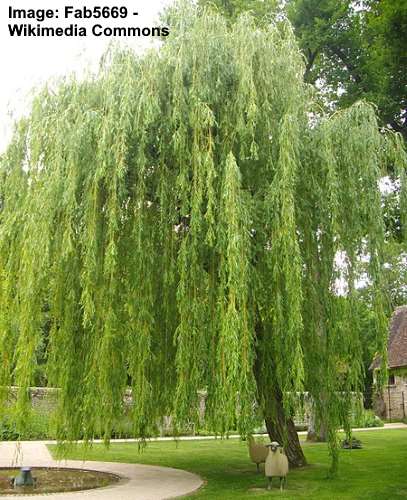
The weeping willow tree grows quickly and can be easily identified by its droopy branches
The weeping willow is a rapidly growing shade tree with eye-catching pendulous branches that cascade down to the ground. This weeping willow species has a graceful habit of forming a broad, rounded crown. Its leaves are light green, with narrow lanceolate blades, and the weeping tree has clusters of long yellowish flowers.
A weeping willow will not only enhance shade in a sunny garden but will also make a strong statement. The tree performs best in USDA zones 6 through 8 in full sunlight and moist ground. You can also plant the spectacular shade tree near streams and ponds.
Weeping willows grow quickly to reach a height and width of 30 to 40 ft. (9 – 12 m).
Related reading: Other types of fast-growing willow trees for shade.
- USDA Hardiness Zone: 6 through 8
- Sun Exposure: Full sun
- Growth Rate per Year: Quickly to reach a height and width of 30 to 40 feet (9 to 12 meters)
- Mature Height: Between 30 and 40 feet (9 to 12 meters)
Hybrid Poplar (Populus deltoides x Populus nigra)
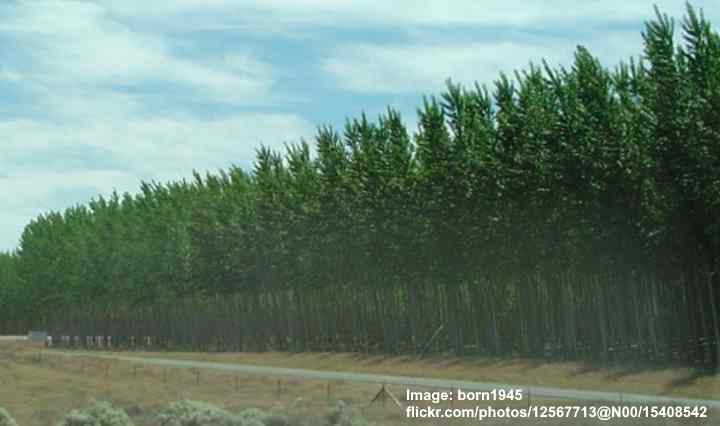
The fast growing hybrid poplar makes it the ultimate tree for creating a tall privacy fence
The hybrid poplar is one of the fastest-growing trees for privacy and shade in a garden landscape. This poplar is known for its rapid growth, adding between 5 and 8 ft. (1.5 – 2.4 m) annually. The poplar tree is identified by its silvery-green, triangular leaves, black bark, and oval canopy.
There are many poplar species of trees suitable as a windbreak, screening tree, or privacy hedge. This cultivar is popular because it doesn’t produce cottony growths in spring, resulting in less mess. The privacy tree grows between 40 and 50 ft. (12 – 15 m) high and spreads up to 30 ft. (9 m) wide.
The hybrid poplar thrives in USDA zones 3 to 9, making it ideal as a privacy tree throughout the United States and as far south as northern Florida.
- USDA Hardiness Zone: 3 to 9
- Sun Exposure: Full sun
- Growth Rate per Year: Rapid growth, adding between 5 and 8 feet (1.5 to 2.4 meters) annually
- Mature Height: Between 40 and 50 feet (12 to 15 meters) high and spreads up to 30 feet (9 meters) wide
Flowering Dogwood Tree (Cornus florida)
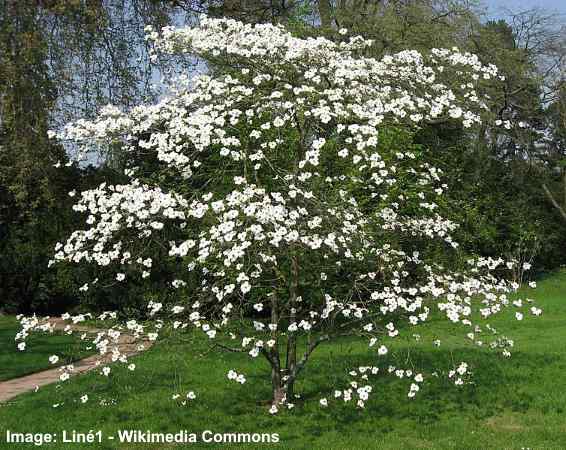
The fast growing dogwood tree is relatively small and has attractive white flowers
One of the most beautiful flowering shade trees that grows rapidly is the flowering dogwood. The small shade tree has a low branching habit with a broadly-pyramidal canopy. Ornamental features of the tree are its large white star-like blooms, medium-green leaves, and eye-catching red berries. In addition, the canopy of layered branches provides shade in the summer.
Flowering dogwood grows well in USDA zones 5 to 9, with full sun to partial shade and average soil conditions. The small shade tree grows 15 to 30 ft. (5 – 9 m) tall and wide.
An identifying feature of dogwood trees is their attractive, dark gray to black bark that develops into small, rough, scaly blocks resembling alligator skin.
Related reading: Dogwood trees with red berries.
- USDA Hardiness Zone: 5 to 9
- Sun Exposure: Full sun to partial shade
- Growth Rate per Year: Rapid growth
- Mature Height: Between 15 and 30 feet (5 to 9 meters)
Tuliptree (Liriodendron tulipifera)
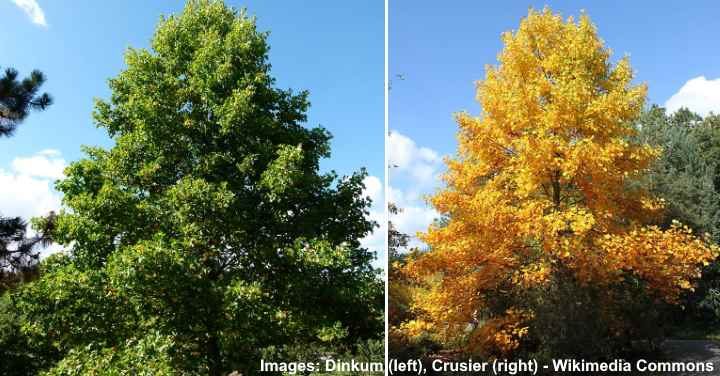
Tulip poplar trees – summer and autumn foliage
The tuliptree is an impressive deciduous tree with a pyramidal shape, making it ideal as a shade tree for large yards. Features of the tuliptree are its yellowish-green tulip-like flowers, glossy green foliage, and brilliant golden-yellow colors in the fall. This attractive flowering shade tree thrives in USDA zones 4 through 9. Tuliptrees typically grow between 80 and 150 ft. (24 – 45 m) tall and up to 50 ft. (15 m) wide.
The tuliptree has several charming qualities, making it ideal for garden landscapes. The cup-shaped yellowish-green flowers bloom in spring and early summer, contrasting with the four-lobed glossy green leaves. Additionally, the large shade tree has unusual conical fruit.
- USDA Hardiness Zone: 4 to 9
- Sun Exposure: Full sun
- Growth Rate per Year: More than 2 feet (0.6 meters)
- Mature Height: Between 80 and 150 feet (24 to 45 meters)
American Sycamore (Platanus occidentalis)
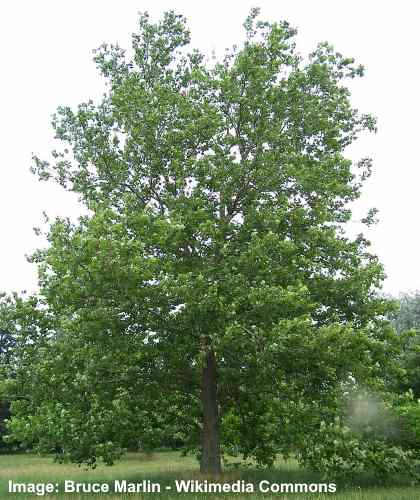
The large American sycamore tree grows fast and is often found along streams, rivers and wetland areas
The American sycamore tree is a sizable deciduous shade tree with rapid growth. Some of the identifying features of the American sycamore are its large maple-shaped leaves, clusters of spring flowers, and spiky balls that appear in the fall. However, its most notable feature is the camouflage-like gray, brown, and creamy-white bark.
This magnificent landscaping tree grows 100 to 130 ft. (30 – 40 m) tall and 40 ft. (12 m) wide. The huge shade trees perform best in full sun in USDA zones 4 through 9.
- USDA Hardiness Zone: 4 to 9
- Sun Exposure: Full sun
- Growth Rate per Year: Rapid growth
- Mature Height: Between 100 and 130 feet (30 to 40 meters)
Quaking Aspen (Populus tremuloides)
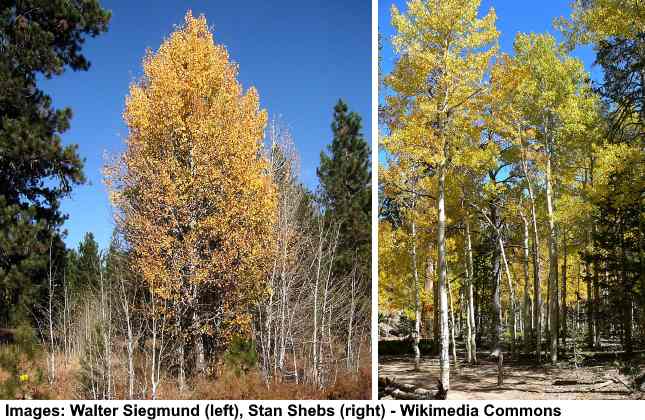
Quaking Aspen trees (Populus tremuloides)
The quaking aspen is a deciduous tree with an impressive growth rate of 5 ft. (1.5 m) per year. The beautiful shade tree has distinctive leaves that flutter and tremble in the slightest breeze. The tree is also identified by its slender trunk with white bark, pyramidal habit, and finely-toothed green leaves.
Quaking aspens grow quickly up to 50 ft. (15 m) tall, and their suckering habit forms large colonies. An attractive feature of the tree is its vibrant fall foliage that turns a brilliant yellow or golden color. It is one of the most attractive fast-growing shade trees for cool summer climates.
- USDA Hardiness Zone: 2 to 8
- Sun Exposure: Full sun
- Growth Rate per Year: Up to 5 feet (1.5 meters) annually
- Mature Height: 20 to 50 feet (6 to 15 meters)
Carolina Poplar (Populus x canadensis)
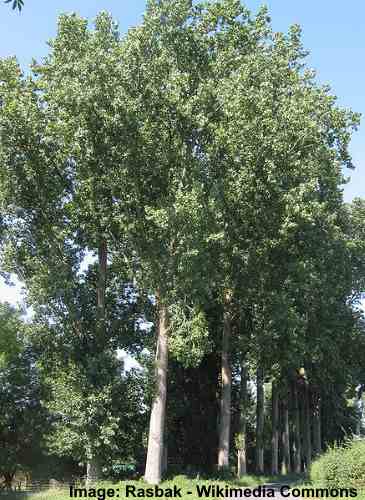
Canadian poplar trees (Populus × canadensis)
The Carolina poplar is a fast-growing shade tree thanks to its annual rapid growth of 5 ft. (1.5 m). The deciduous tree is recognized by its triangular leaves, dangling creamy-white flower clusters, and light brown fissured bark. The poplar hybrid tree also has vibrant fall colors when the green leaves turn golden yellow.
This fast-growing, cold-hardy tree reaches heights of up to 50 ft. (15 m). The poplar shade tree prefers moist, fertile, well-drained soils. Due to its large, broad canopy, the Carolina poplar is a common shade tree in parks, large landscapes, and along streets and highways.
Also called the Canadian poplar, other fast-growing cultivars include the golden poplar (Populus x canadensis ‘Aurea’) and ‘Robusta’ (Populus x canadensis ‘Robusta’). These cultivars grow rapidly with little maintenance.
- USDA Hardiness Zone: 3 to 9
- Sun Exposure: Full sun
- Growth Rate per Year: 6 to 5 feet (0.8 to 1.5 meters) per year for the first ten years
- Mature Height: Between 40 and 50 feet (12 to 15 meters)
Japanese Pagoda (Sophora japonica)
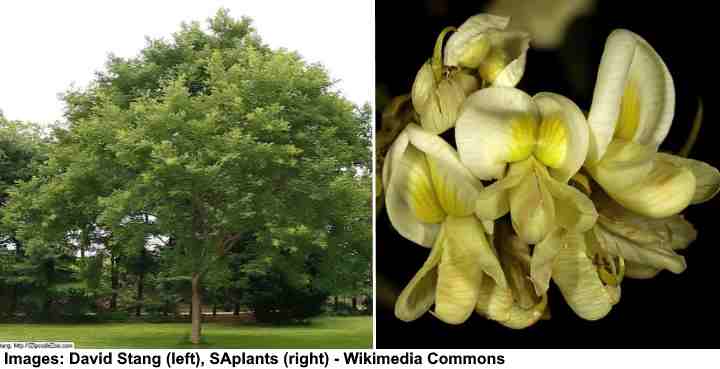
A Japanese pagoda (Sophora japonica) tree and flowers
The Japanese pagoda is a deciduous tree with a rapid growth rate. The popular shade tree thrives in full sun and blooms in mid to late summer with greenish-white or yellow flowers. This attractive tree has a spreading, rounded crown and can reach heights up to 70 ft. (21 m).
In addition to its stunning flowers, the Japanese Pagoda tree has attractive compound leaves with 7 to 17 leaflets. The creamy-white or yellow flowers are followed by attractive yellow fruit pods 12” (30 cm) long from late summer through winter. The tough, urban tree is suited to growing as a shade tree in drought-prone landscapes.
If you want an attractive Japanese pagoda tree, choose the ‘Pendula’ cultivar. This ornamental tree has a weeping habit formed by drooping branches. It has eye-catching yellow foliage and grows 50 to 70 ft. (15 – 21 m) tall.
- USDA Hardiness Zone: 5 to 8
- Sun Exposure: Full sun
- Growth Rate per Year: Rapid growth up to 1 foot (0.3 meters)
- Mature Height: 40 to 70 feet (12 to 21 meters)
White Ash (Fraxinus americana)
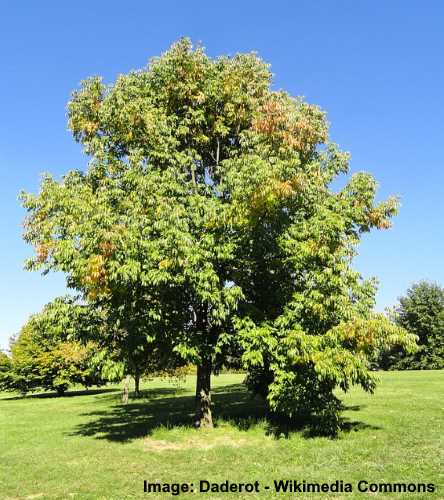
White ash (Fraxinus americana)
The white ash has an excellent growth rate of 3 to 5 ft. (1 – 1.5 m) annually. This deciduous medium to large-sized shade tree is known for showy purplish flower clusters in spring, pinnate compound leaves that turn purple, red, or yellow in the fall, and winged fruits in the summer.
This fast-growing ash variety reaches up to 120 ft. (36 m) tall in USDA zones 3 to 9. The large shade tree has a rounded crown and grayish-brown bark. Its fragrant flowers attract pollinators and butterflies in late spring and summer. It’s also tolerant of damp soils and urban pollution.
- USDA Hardiness Zone: 3 to 9
- Sun Exposure: Full sun
- Growth Rate per Year: Fast growth of 3 to 5 feet (1 to 1.5 meters)
- Mature Height: Between 60 and 120 feet (18 to 36 meters)
Cleveland Pear (Pyrus calleryana ‘Cleveland Select’)
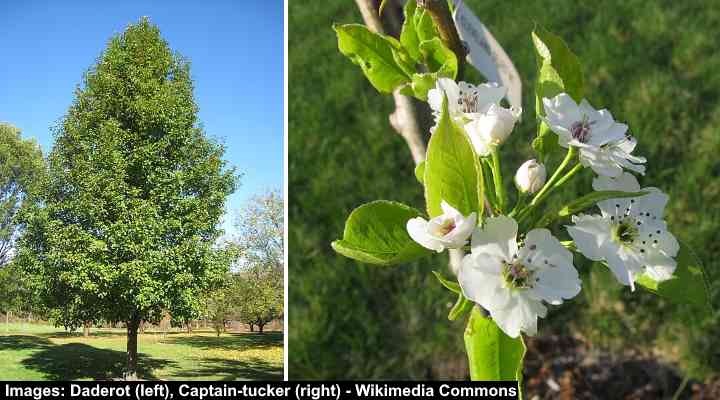
A Cleveland pear tree (Pyrus calleryana ‘Cleveland Select’) and flowers
The deciduous ‘Cleveland Select’ ornamental pear grows rapidly in sunny landscapes, filling spring gardens with beautiful white flowers. The profusion of white, fragrant flowers contrasts nicely with the glossy green, oval leaves. The tree’s beauty is enhanced in the fall when its foliage turns vibrant reddish-purple colors
With its fast growth rate of 4 ft. (1.2 m) per year and attractive ornamental features, the Cleveland pear is a popular choice for landscaping projects. The decorative flowering tree is ideal for compact gardens, providing shade, spring blooms, and lush texture. It is an ideal fruit tree for enhancing the aesthetic appeal of outdoor spaces.
- USDA Hardiness Zone: 4 to 9
- Sun Exposure: At least six hours of sunlight daily
- Growth Rate per Year: up to 4 feet (1.2 meters)
- Mature Height: 25 to 30 feet (7.6 to 9 meters) tall and up to 20 feet (6 meters) wide
Dawn Redwood (Metasequoia glyptostroboides)
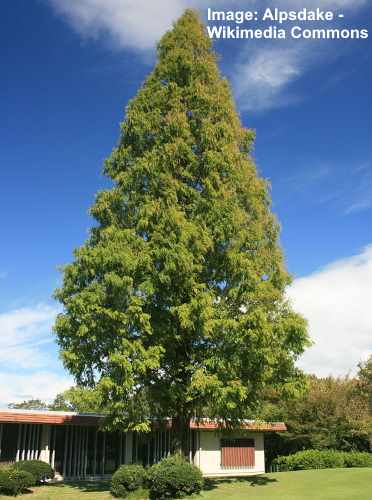
Dawn redwood (Metasequoia glyptostroboides)
The dawn redwood is a deciduous tree with rapid growth, a pyramidal habit, and feathery, fern-like leaves. This large coniferous tree has deep-green needle-like leaves that turn red-bronze in the fall. The tree grows at a rate of 3 to 4 ft. (1 – 1.2 m) annually, up to 100 ft. (30 m). It also has spreading, slightly drooping branches.
One of the most interesting features of the dawn redwood is its unique reddish-brown bark. The tree trunk has a fluting growth habit at its base, and the fissured bark peels off in strips. This redwood conifer also produces dark-brown barrel-like cones that measure 0.5” (1.3 cm) long. Dawn redwoods thrive in moist, well-drained soils.
- USDA Hardiness Zone: 4 to 8
- Sun Exposure: Full sun
- Growth Rate per Year: Fast growth, 3 to 4 feet (1 to 1.2 meters) annually
- Mature Height: 60 to 100 feet (18 to 30 meters)
Mimosa Tree (Albizia julibrissin)

Mimosa tree (Albizia julibrissin)
Growing up to 3 ft. (1 m) per year, the mimosa tree is a stunning deciduous tree with fluffy, pink, powder puff flowers. The fast-growing tree is identified by its spreading, umbrella-like canopy, fern-like leaves, and showy pink summer flowers. The mimosa tree has a vase-shaped canopy up to 50 ft. (15 m) wide.
The mimosa tree is an ideal shade tree in gardens and landscapes. In addition to its attractive foliage and flowers, the tree also produces flat, brown seed pods. These slender pods measure 7” (17 cm) long, adding visual interest to the tree in fall and winter. The rapidly growing tree thrives in well-drained soil and summer heat and humidity.
- USDA Hardiness Zone: 6 to 9
- Sun Exposure: Full sun to light shade
- Growth Rate per Year: Fast growth, up to 3 feet (1 meter) annually
- Mature Height: Between 20 and 40 feet (3 to 12 meters) tall and 20 to 50 feet (6 to 15 meters) wide
Bald Cypress (Taxodium distichum)
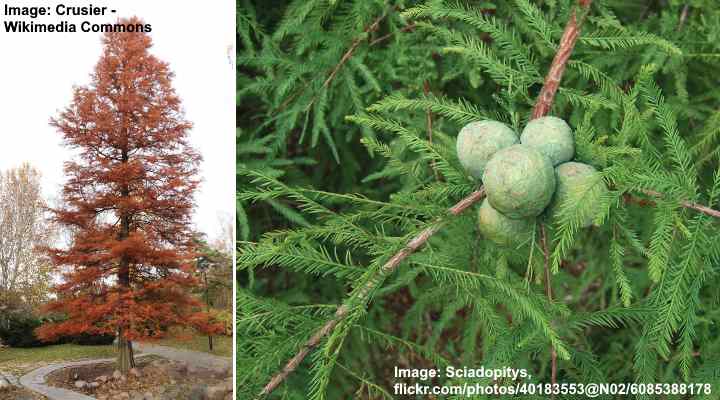
A bald cypress (Taxodium distichum) tree in autumn, foliage and cones
The bald cypress is a tall deciduous tree with a moderately fast growth rate, reaching heights up to 100 ft. (30 m). This large shade tree has a pyramidal shape and feathery, needle-like leaves that turn a beautiful reddish-brown in the fall. An identifying feature of the coniferous tree is its thicker base.
Bald cypress trees are native to the southeastern United States. They thrive in wet conditions and are common in swamps and along riverbanks. The tall trees are ideal for erosion control and to create natural buffers near bodies of water. You can also plant bald cypress trees as a large shade tree or tall hedge.
- USDA Hardiness Zone: 5 to 910
- Sun Exposure: Full sun to partial shade
- Growth Rate per Year: Moderately fast, growing up to 50 feet (15 meters) in 20 years
- Mature Height: 60 to 100 feet (18 to 30 meters) tall and 25 to 35 feet (7.6 to 10 meters) wide
European Black Alder (Alnus glutinosa)
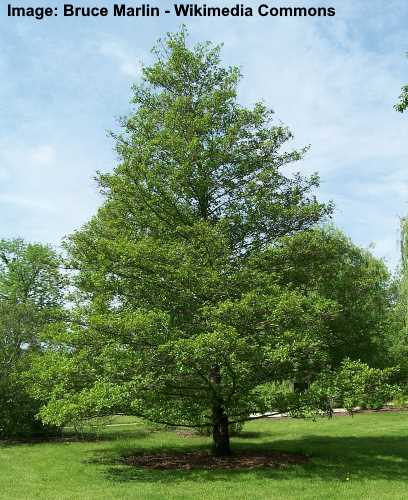
A black alder (Alnus glutinosa) tree
The European black alder is a fast-growing ornamental shade tree with a pyramidal canopy. The deciduous tree is identified by its dark green, glossy leaves, dangling cylindrical flower clusters in early spring, and wood seed-containing cones in the fall. The winged seeds measure 0.75” (2 cm) long.
The European black alder thrives in most soil types and performs particularly well in wet soils or coastal gardens. Additionally, the tree is a “nitrogen-fixer” and grows well in poorer soils, helping to improve soil fertility.
Other common black alder cultivars for landscaping include ‘Aurea,’ with its golden yellow leaves, ‘Pyramidalis,’ with its upright, columnar form, and ‘Fastigiata,’ with its narrow, pencil-like form.
- USDA Hardiness Zone: 3 to 7
- Sun Exposure: Full sun to partial shade
- Growth Rate per Year: Rapid growth, up to 3 feet (0.9 meters) annually
- Mature Height: 40 to 50 feet (12 to 15 meters) tall and up to 40 feet (12 meters) wide
Southern Catalpa (Catalpa bignonioides)
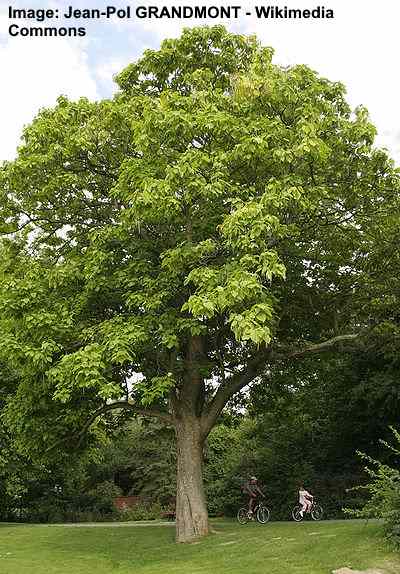
A southern catalpa (Catalpa bignonioides) tree
The southern catalpa is a deciduous tree with a rapid growth habit and broad, irregular canopy. The sun-loving tree has white or purple flowers that bloom throughout summer. The fragrant flowers contrast nicely with the large, heart-shaped leaves and fragrant white flowers. This shade tree has a short, thick trunk and grows up to 60 ft. (18 m).
An eye-catching future of the catalpa tree is its long, bean-like seed. These pods grow 15” (38 cm) long and persist on the dark brown zig-zag branches through the winter months. Due to its huge, spreading canopy, the southern catalpa provides ample shade in large garden landscapes.
- USDA Hardiness Zone: 5 to 9
- Sun Exposure: Full sun to partial shade
- Growth Rate per Year: Fast growth, up to 2 feet (0.6 meters)
- Mature Height: Between 40 and 60 feet (12 to 18 meters) and up to 40 feet (12 meters) wide
Blue Paloverde (Parkinsonia florida)
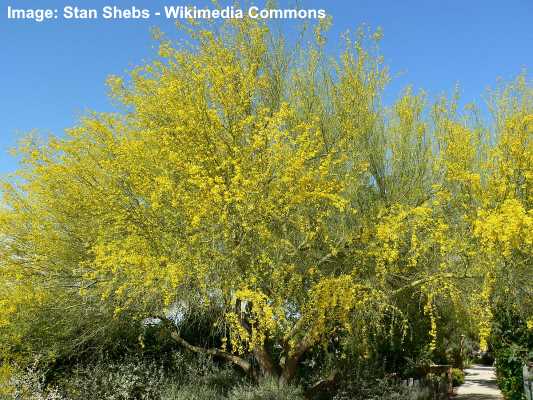
A blue palo verde (Parkinsonia florida) tree in bloom
The fast-growing blue paloverde tree is well suited to growing in desert landscapes. The eye-catching identifying features of the deciduous tree are its blue-green trunk, pinnately compound leaves, and bright golden-yellow flowers that bloom in the spring. The loose, spreading crown creates dappled shade in tropical garden landscapes.
Blue paloverde trees are covered in bright yellow flowers from spring through summer. These fragrant nectar-rich blooms attract hummingbirds, bees, butterflies, and other insects. This small to medium-sized tree doesn’t grow taller than 25 ft. (8 m), making it an ideal shade tree for hot, dry climates.
- USDA Hardiness Zone: 8 to 11
- Sun Exposure: Full sun
- Growth Rate per Year: Fast growth, up to 3 feet (1 meter)
- Mature Height: Between 20 and 25 feet (6 to 8 meters) and up to 20 feet (6 meters) wide
White Poplar (Populus alba)
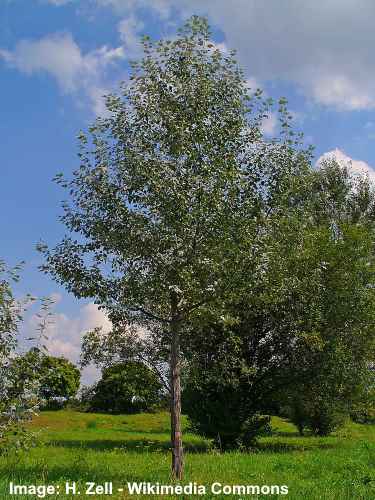
White Poplar Tree (Populus alba)
The white poplar is a deciduous native tree with rapid growth, reaching 16 ft. (5 m) in the first four years. This shade tree is known for its yellow spring-blooming flowers, dark green lobed leaves with a fuzzy, white underside, and small fuzzy seed pods. The fast-growing tree can grow up to 100 ft. (30 m).
White poplars are practical, fast-growing shade trees well-suited for cool summer climates. The tree grows up to 5 ft. (1.5 m) per year in ideal conditions. It tolerates most soils and has a high drought and salt tolerance, making it ideal for beachfront gardens and coastal areas.
- USDA Hardiness Zone: 4 to 9
- Sun Exposure: Full sun to partial shade
- Growth Rate per Year: Fast growth between 3 and 5 feet (1 to 1.5 m)
- Mature Height: 60 to 100 feet (18 to 30 m) tall and up to 50 feet (15 m) wide
Black Willow (Salix nigra)
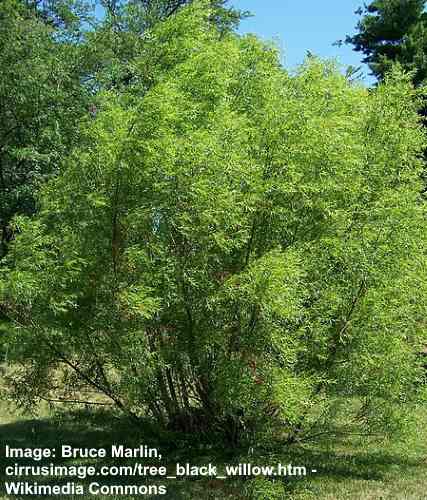
A black willow (Salix nigra) tree can have single or multiple trunks
The black willow grows rapidly in wet soils and full sun to partial shade. Blooming in mid to late spring, the deciduous tree has slender, elongated lanceolate leaves 5” (13 cm) long. Its spring-blooming flowers are catkins—dangling cylindrical clusters—measuring 2” (5 cm) long. In summer, reddish-brown seed capsules appear on the tree.
The black willow is a great choice for growing shade trees near bodies of water or wetlands. The easy-care tree grows up to 60 ft. (18 m) tall, and its shallow, spreading root system helps stabilize soil and prevent erosion. With its wide canopy, black willow is ideal as a shade tree in large open landscapes.
- USDA Hardiness Zone: 4 to 9
- Sun Exposure: Full sun or partial shade
- Growth Rate per Year: 2 to 3 feet (0.6 to 1 meter)
- Mature Height: 30 to 60 feet (9 to 18 meters)
Red Oak (Quercus rubra)
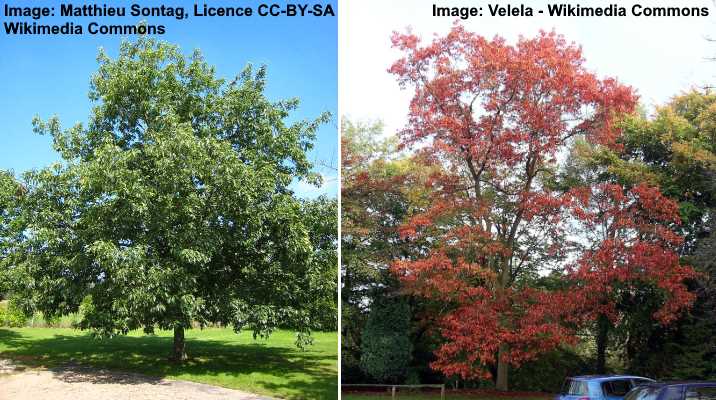
The red oak (Quercus rubra) is a fast growing long-lived deciduous tree with beautiful fall colors
Red oak is a deciduous tree renowned for its impressive size and fast yearly growth of 2 ft. (0.6 m). The fast-growing deciduous tree has lustrous dark green leaves, each with up to 11 bristle-tipped lobes. Additionally, the native oak has yellowish-green catkins blooming in spring.
In fall, red oak tree foliage turns an impressive russet-red, adding striking seasonal color to autumn landscapes. The tree has an attractive, broad, rounded canopy that provides ample shade and privacy. Additionally, it requires little maintenance when growing in full sun or partial shade, and it is drought-tolerant when established.
- USDA Hardiness Zones: 3-8
- Sun Exposure: Full sun to partial shade
- Growth Rate per Year: Moderate to fast, about 1 to 2 feet (0.3 to 0.6 meters) per year
- Mature Height: 50 to 70 feet (15 to 21 meters) tall and wide
Pink Oak (Quercus palustris)
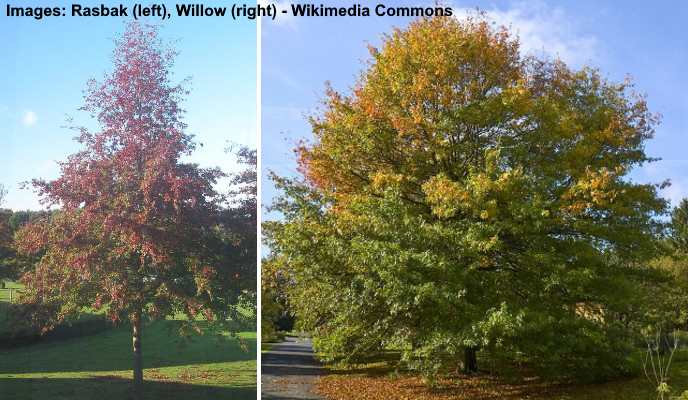
Young and mature pink oak trees (Quercus palustris)
The pink oak is an attractive deciduous tree with a rapid growth rate. This shade tree is recognized by its distinctive pyramidal crown when young, and becomes rounded as the tree matures. glossy green leaves with five to seven sharply pointed lobes, and inconspicuous yellowish-green catkins blooming in spring. The ornamental oak tree has stunning, vibrant red or pink colorful foliage in the fall.
With a rapid growth rate of 2 ft. (0.6 m) annually, the pink oak is a popular landscaping choice for shade gardens or as a specimen tree in lawns. The tree thrives in full sun and medium to wet, acidic soils. It is one of the easiest oaks to transplant, making it useful in landscaping projects.
The pink oak also goes by the names pin oak and Spanish oak. It is a member of the red oak section of trees in the genus Quercus.
- USDA Hardiness Zone: 5 to 8
- Sun Exposure: Full sun to partial shade
- Growth Rate per Year: Rapid growth up to 2 feet (0.6 meters)
- Mature Height: 50 to 70 feet (15 to 21 meters) tall and up to 60 feet (18 meters) wide
Box Elder (Acer negundo)

A box elder tree (Acer Negundo)
The box elder tree rapidly grows when young, averaging 2 ft. (0.6 m) per year for the first 20 years. The fast-growing deciduous shade tree is characterized by its light green pinnately compound leaves growing on widely spreading branches. The leaves comprise up to seven leaflets 6” to 15” (15 – 37 cm) long.
Its fast growth makes box elder a popular cold-hardy, drought-tolerant tree in rural landscapes. However, its weak, brittle wood, susceptibility to pests, and trunk decay make it unsuitable for urban areas or residential gardens. With its upright habit and irregularly round canopy, the medium-sized tree is easy to grow and requires little pruning.
Additionally, box elder trees withstand short flooding periods, making them ideal for planting in riparian areas, along streams, and in wetlands.
- USDA Hardiness Zone: 2 to 10
- Sun Exposure: Full sun or partial shade
- Growth Rate per Year: Up to 2 feet (0.6 meters)
- Mature Height: 30 to 50 feet (10 to – 15 meters) tall and wide
Jerusalem Thorn (Parkinsonia aculeata)
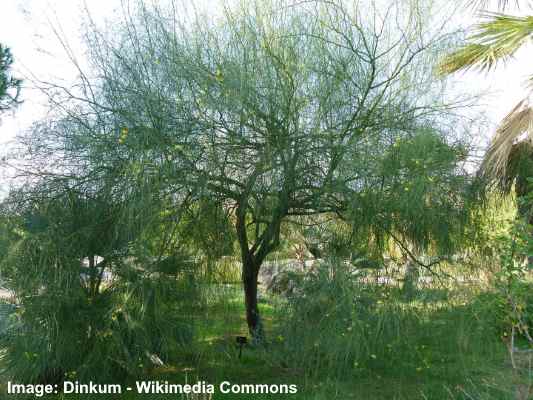
A Jerusalem Thorn (Parkinsonia aculeata) tree
The Jerusalem thorn is an unusual fast-growing deciduous tree due to its green bark and long blooming season starting in spring. This tree has a unique, open, and airy growth habit with thorny branches. Jerusalem thorn is identified by its bright golden-yellow spring flowers, long bean-like seed pods, and green leaves that drop off in summer.
Jerusalem thorn trees don’t grow taller than 20 ft. (6 m). The long-lived, fast-growing tree is tolerant of heat, drought, and humidity, making it ideal for xeriscaping. The Jerusalem thorn is a great addition to arid, desert climates with its year-long blooms and eye-catching bark. You can also train it to grow as a large hedge.
- USDA Hardiness Zone: 8 to 11
- Sun Exposure: Full sun
- Growth Rate per Year: Fast growth, up to 3 feet (1 meter)
- Mature Height: 15 to 20 feet (4.5 to 6 meters) tall and up to 25 feet (7.6 meters wide)
Gold Birch (Betula ermanii)
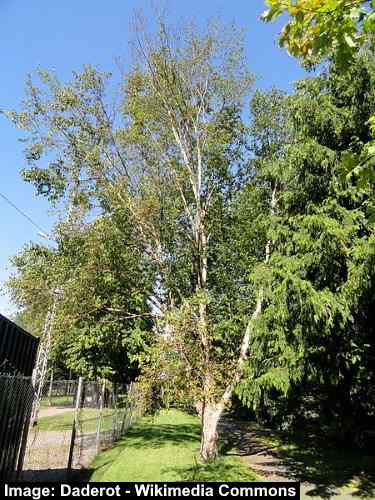
A gold birch (Betula ermanii) tree
The gold birch is a deciduous tree known for its eye-catching creamy-white bark that peels off in thin layers, revealing a reddish-brown inner bark. The fast-growing tree has a broadly conical growth habit, heart-shaped leaves, and yellowish-brown flowering catkins. The tree’s foliage on its attractive canopy turns golden yellow in the fall.
Growing at a rate of up to 2 to 3 ft. (0.6 – 1 m) per year, the gold birch matures around 70 ft. (21 m) tall. You can plant the low-maintenance deciduous tree as a specimen plant in areas of your yard with poor drainage. Its attractive, lush summer foliage and unusual bark give the tree aesthetic value in summer and winter.
- USDA Hardiness Zone: 5 to 8
- Sun Exposure: Full sun, light shade, or partial shade
- Growth Rate per Year: Up to 3 feet (1 meter)
- Mature Height: 40 to 70 feet (12 to 21 meters)
Himalayan Birch (Betula utilis var. jacquemontii)

A Himalayan birch tree (Betula utilis var. jacquemontii) and leaves
The Himalayan birch is a medium to fast-growing deciduous tree that grows up to 10 ft. (3 m) tall in ten years. Identifying characteristics of the deciduous tree are its brilliant white, peeling bark, open pyramidal habit, and ovate, dark green leaves. Additionally, the triangular leaves turn eye-catching golden-yellow shades in the fall.
The Himalayan birch is one of the most popular birch trees, growing 30 to 40 ft. (9 – 12m) tall. The easy-grow, single or multi-stemmed tree thrives in cooler summers and is exceptionally cold-hardy. It also tolerates various well-drained soils, from loamy and sandy to heavy clay. However, it requires constant moisture to thrive as a shade tree.
Thanks to its ornamental features, the Himalayan birch is a great addition and focal point for year-long interest in garden landscapes.
- USDA Hardiness Zone: 4 to 7
- Sun Exposure: Full sun to partial shade
- Growth Rate per Year: Around 2 to 3 feet (0.6 to 0.9 meters)
- Mature Height: 30 to 40 feet (9 to 12 meters)
Black Locust (Robinia pseudoacacia)
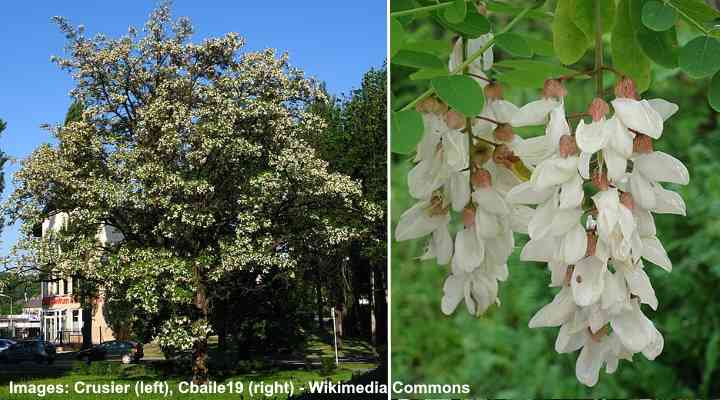
A black locust (Robinia pseudoacacia) tree and flowers
The black locust is a fast-growing deciduous shade tree identified by its fragrant white flowers and dark blue-green leaves. The thorny tree has an impressive growth rate—between 3 and 10 ft. (1 – 3 m) annually. The black locust is known for its fragrant white pea-like spring and summer flowers.
The black locust tree has a narrow, oblong crown that reaches 50 ft. (15 m) tall. In addition to its fragrant white flowers, the tree has stout spines on branches at the leaf base and attractive purple-brown seed pods. It’s a versatile tree that performs well in poor, dry soils and has a good tolerance to drought once established.
- USDA Hardiness Zone: 4 to 9
- Sun Exposure: Full sun
- Growth Rate per Year: 3 to 10 feet (1 to 3 meters)
- Mature Height: 30 to 50 feet (9 to 15 meters)
Chinese Tallow Tree (Sapium sebiferum or Triadica sebifera)
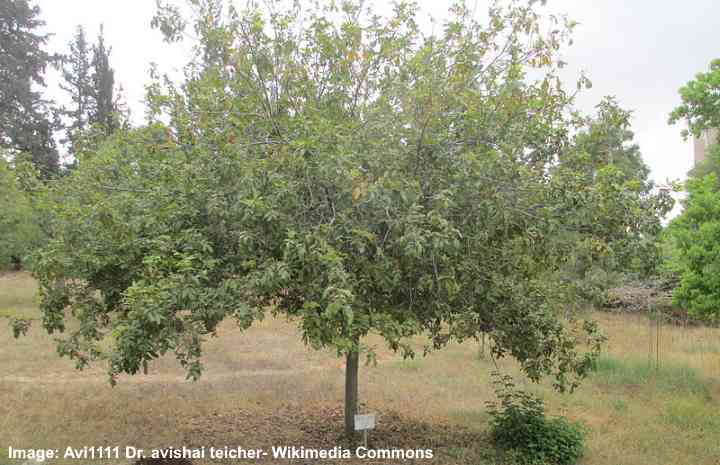
A Chinese tallow tree (Sapium sebiferum or Triadica sebifera)
The Chinese tallow tree is a fast-growing deciduous tree that quickly grows 30 to 40 ft. (9 – 12 m) tall. The multi-trunked deciduous tree has an irregular to rounded crown, medium green heart-shaped leaves, yellowish-green flowers, and lobed seed pods. It is known for its attractive foliage and unique fruit clusters. Its fall colors are red, purple, yellow, and orange.
As fast-growing trees, Chinese tallow trees easily naturalize in the southern United States, like Texas, Florida, and South Carolina. However, its rapid growth in other states makes it a highly invasive plant. Therefore, before planting the Chinese tallow tree, checking its invasiveness in your area is recommended.
In areas where the Chinese tallow tree grows well, it is useful as a small shade tree, lawn specimen, or privacy screen. This tree is adaptable to a wide range of soil types and tolerates drought conditions. Additionally, its fruit clusters are attractive to birds and wildlife.
- USDA Hardiness Zone: 8 to 10
- Sun Exposure: Full sun to partial shade
- Growth Rate per Year: Up to 3 feet (1 meter)
- Mature Height: 40 to 50 feet (12 – 15 meters) tall and 15 to 20 feet (4.5 to 6 meters) wide
Paper Mulberry (Broussonetia papyrifera)
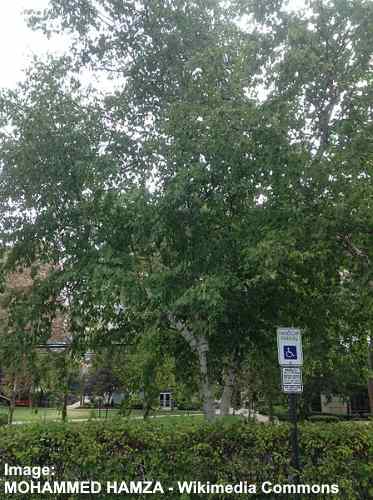
A paper mulberry (Broussonetia papyrifera) tree
The paper mulberry grows rapidly—sometimes aggressively—as a shrub-like tree with interesting variably lobed leaves. Growing up to 50 ft. (15 m), the deciduous tree features a spreading, rounded crown. Its leaves resemble the shape of a hand, and it blooms in spring with red or purple flowers in spherical clusters.
Paper mulberry trees thrive in fertile, well-drained soils. They also tolerate drought, humidity, heat, and urban pollution, making them highly versatile plants for warmer climates. However, the tree is on the list of invasive plants in some areas like Florida, South Carolina, Georgia, and Tennessee.
- USDA Hardiness Zone: 6 to 9
- Sun Exposure: Full sun
- Growth Rate per Year: It takes 12 months to grow 13 ft. (4 m)
- Mature Height: 40 to 50 feet (12 to 15 meters) tall and up to 40 feet (12 m) wide
Fast-Growing Evergreen Trees
Evergreen trees are some of the best types of trees for privacy. Typically, they have dense foliage that creates a protective hedgerow or screening around a front or backyard. But what are the best fast-growing trees for privacy? Please read on to find out.
Thuja ‘Green Giant’ – (Thuja plicata x standishii ‘Green Giant’) – Fast Growing Privacy Tree
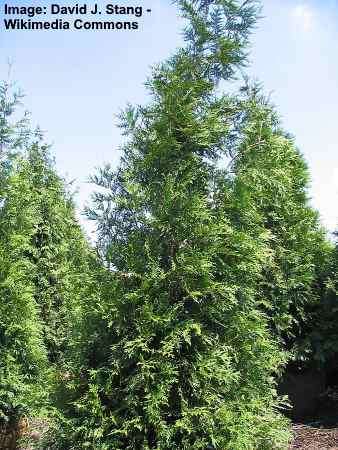
For fast growing living privacy fence choose arborvitae evergreen trees such as the Thuja ‘Green Giant’
Also called the Green Giant Arborvitae, this thuja hybrid is one of the fastest-growing evergreens for privacy hedge. Growing at 3 to 5 ft. (1 – 1.5 m) annually, the large tree has soft, feathery foliage and an elegant pyramidal growth habit. The hybrid thuja performs best in full sun and well-drained soil.
The dense evergreen foliage of the Green Giant thuja makes it ideal for protecting your privacy around your property. Planted as a tall hedgerow, the arborvitae blocks noise, unsightly views, and noisy neighbors.
The Green Giant arborvitae grows 40 to 60 ft. (12 – 18 m) tall and up to 18 ft. (5.5 m) wide.
- USDA Hardiness Zone: 3 to 9
- Sun Exposure: Full sun
- Growth Rate per Year: 3 to 5 feet (0.9 to 1.5 meters)
- Mature Height: Between 40 and 60 feet (12 to 18 meters)
Leyland Cypress (Cupressus × leylandii) – Fast Growing Privacy Tree
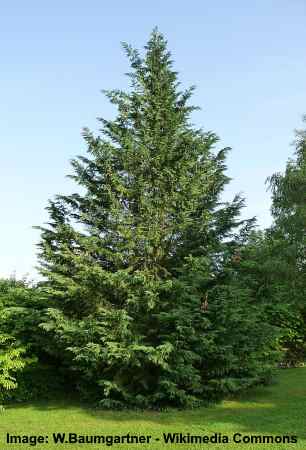
Leyland cypress is a fast growing evergreen tree which can be used for privacy screen
The Leyland cypress is a popular, fast-growing evergreen tree used for privacy, hedgerows, or noise-blocking borders. This impressive conifer has a broad columnar to pyramidal habit, flattened sprays of green foliage, and reddish-brown scaly bark. The rapid growth of Leyland cypress trees makes them perfect for evergreen landscaping.”
The Leyland cypress can grow 60 to 70 ft. (18 – 21 m) tall with a spread of 10 to 15 ft. (3 – 4.5 m) wide. It has an impressive growth rate for cold-hardy coniferous trees of 3 ft. (1 m) per year. Suitable for USDA zones 6 through 10.
- USDA Hardiness Zone: 6 to 10
- Sun Exposure: Full sun
- Growth Rate per Year: Approximately 3 feet or more (0.9 meters or more)
- Mature Height: Between 60 and 70 feet (18 to 21 meters)
Italian Cypress (Cupressus sempervirens)
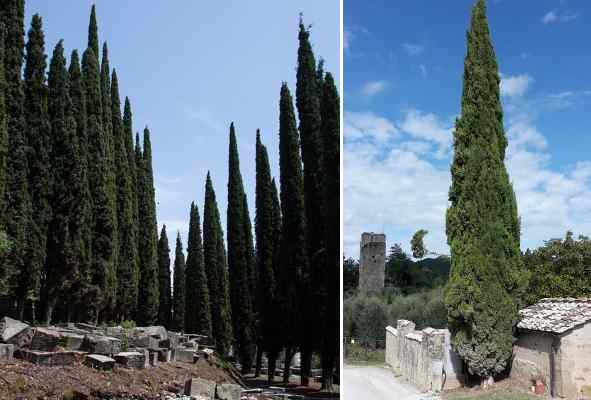
The tall narrow Italian cypress gives a stunning focal point in the landscape or it can be used as fast growing privacy screen when planted in a row
The Italian cypress is a tall coniferous tree with bluish-green needles, a thin, columnar shape, and rapid growth. Planted in a row, this cypress specimen creates a tall privacy screen or windbreak. Additionally, the pencil-like erect evergreen tree is low maintenance and tolerant of salt and drought.
The Italian cypress grows 40 to 70 ft. (12 – 21 m) tall and only 6 ft. (3 m) wide. The skinny conifer tree, with its soft scale-like foliage and round seed cones, is an attractive addition to sunny landscapes where shade and privacy are required.
Suitable for growing in USDA zones 7 through 9.
- USDA Hardiness Zone: 7 to 9
- Sun Exposure: Full sun
- Growth Rate per Year: Rapid growth
- Mature Height: Between 40 and 70 feet (12 to 21 meters)
Eastern White Pine Tree (Pinus strobus)
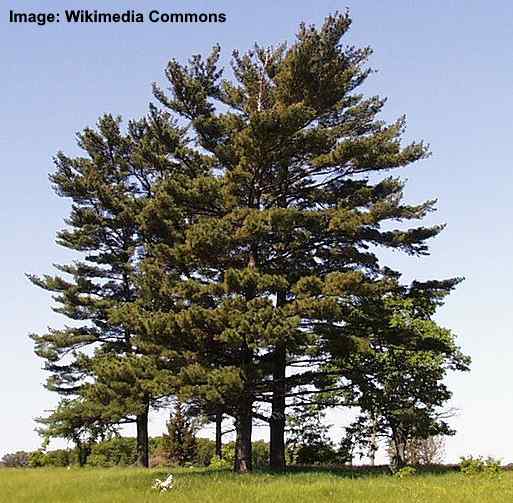
The large and fast growing eastern white pine tree is suitable as a shade tree in cooler climates
The eastern white pine is one of the fastest-growing pine trees suitable for privacy screens or shade trees. The tall conifer grows 50 to 80 ft. (15 – 24 m) tall and up to 40 ft. (12 m) wide. Its identifying characteristics include bluish-green needle leaves, reddish-brown bark, and narrow, cylindrical pine cones.
The rapid growth rate of more than 2 ft. (0.6 m) per year and its wide, dense canopy make the eastern white pine tree perfect for screening large yards. Additionally, it is an excellent coniferous shade tree for colder climates as it thrives in USDA zones 3 through 8.
- USDA Hardiness Zone: 3 to 8
- Sun Exposure: Full sun
- Growth Rate per Year: More than 2 feet (0.6 meters)
- Mature Height: Between 50 and 80 feet (15 to 24 meters)
Eastern Red Cedar (Juniperus virginiana)
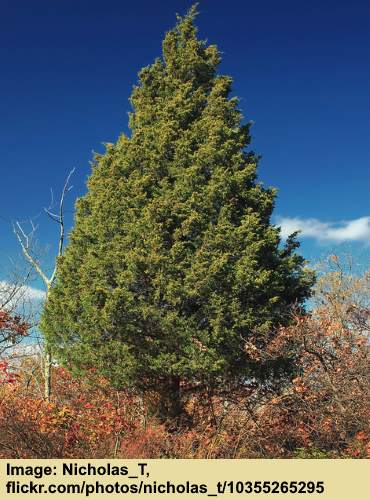
Eastern red cedar (Juniperus virginiana) is not a true cedar but a type of juniper tree
The eastern red cedar is an evergreen shade tree with a medium to fast growth rate. The identifying features of the conifer are its red-brown bark that exfoliates in strips, spherical bluish-purple cones, and silvery-green scale-like leaves. It has a growth rate of 1 to 2 ft. (0.3 – 0.6 m) per year.
The eastern red cedar is cold hardy in USDA zones 2 through 9, making it suitable as a shade and privacy tree throughout most of the United States.
- USDA Hardiness Zone: 2 to 9
- Sun Exposure: Full sun
- Growth Rate per Year: 1 to 2 feet (0.3 to 0.6 meters)
- Mature Height: Varies, typically up to 70 feet (up to 21 meters)
Southern Magnolia Tree (Magnolia grandiflora)
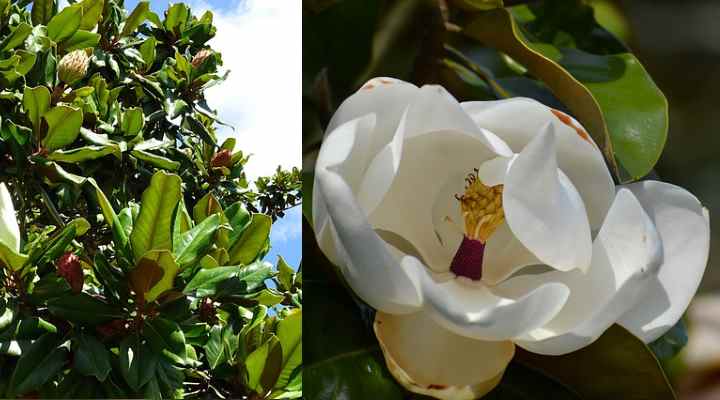
A southern magnolia (Magnolia grandiflora) tree and flower
The southern magnolia tree is a large, evergreen, white-flowering tree with a moderate to fast growth rate. Blooming in summer, this iconic tree is known for its large, showy ivory-white cup-shaped flowers, glossy, dark green leaves, and cone-like seed pods containing bright red seeds. It also has a pyramidal shape and a dense canopy.
The southern magnolia is a beautiful landscaping tree for adding color, fragrance, and texture to mild winter gardens. The tree’s fragrant flowers attract pollinators, and its dense foliage provides shade and privacy. It’s easy to grow in warm, temperate landscapes where it tolerates most well-drained soils.
- USDA Hardiness Zone: 7 to 9
- Sun Exposure: Full sun to partial shade
- Growth Rate per Year: Moderate to fast growth rate at 1.5 to 2 feet (0.5 to 0.6 meters)
- Mature Height: 60 to 80 feet (18 to 24 meters) tall and 30 to 50 feet (9 to 15 meters) wide
Gum Trees (Eucalyptus spp.)
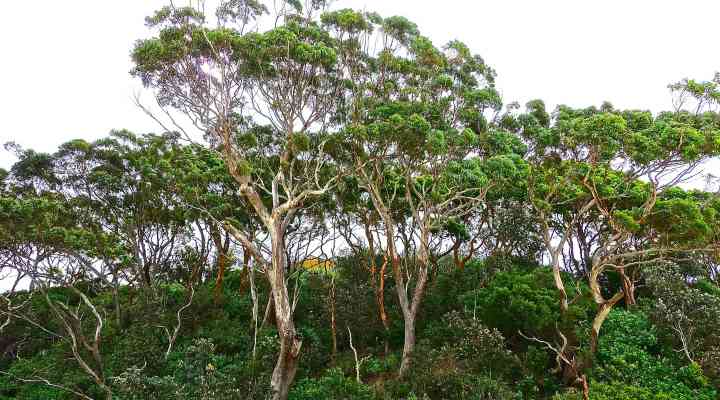
Gum trees (Eucalyptus spp.)
Gum trees are one of the fastest-growing shade trees. They have a rapid growth rate, with some trees adding 6 to 10 ft. (1.8 – 3 m) in height annually. Gum trees are known for their fragrant, silvery-green leaves, bunches of white flowering clusters, and woody capsules called gumnuts.
Gum trees are adaptable to a wide range of soil types. They perform best in well-drained soils and colonize quickly in warm climates. Their tall growth and broad canopy make them ideal for adding shade and beauty to garden landscapes in subtropical and tropical climates.
Here are some of the most popular gum tree varieties in North America:
Blue Gum (Eucalyptus globulus): A tall evergreen tree native to Australia with distinctive blue-gray leaves. The common eucalyptus tree grows 40 to 50 ft. (12 – 15 meters) tall.
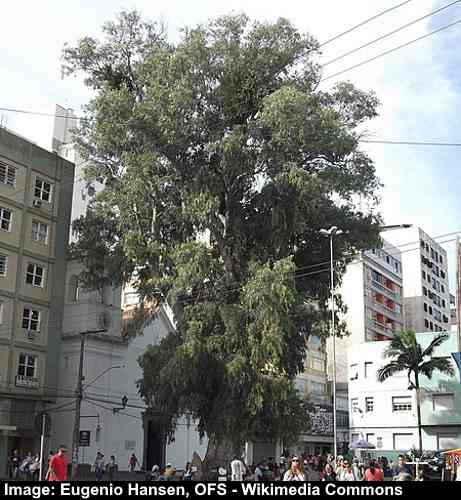
A blue gum (Eucalyptus globulus) tree
Lemon-Scented Gum (Corymbia citriodora): This evergreen eucalyptus tree features smooth, lemon-scented bark, lance-shaped leaves with a strong citrus fragrance, and clusters of cream-colored flowers. It grows 40 to 50 feet (12 to 15 meters) tall.
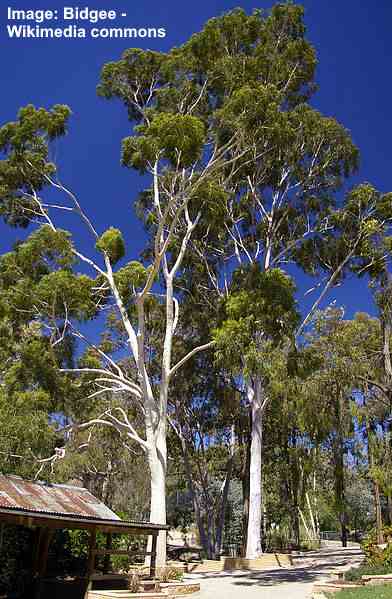
Lemon eucalyptus trees (Eucalyptus citriodora syn. Corymbia citriodora)
Red Flowering Gum (Corymbia ficifolia): This Australian native tree is known for its striking, large, red flowers contrasting with glossy green leaves. This fast-growing evergreen red-flowering tree is valued for ornamental landscaping. It doesn’t grow taller than 40 feet (12 m) tall.

A red flowering gum (Corymbia ficifolia) tree
Silver Dollar Gum (Eucalyptus cinerea): This evergreen tree has distinctive round, silvery-blue aromatic leaves. It brightens tropical landscapes with its shiny leaves. It rapidly grows at an astonishing 6 to 8 feet (1.8 – 2.4 m) per season, and grows to a height of 15–52 ft. (4.5–16 m) tall.
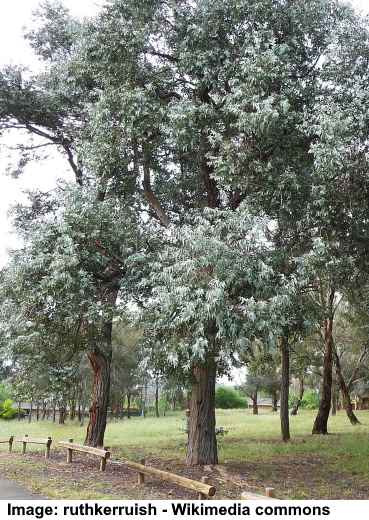
Silver dollar eucalyptus trees (Eucalyptus cinerea)
- USDA Hardiness Zone: 8 to 10
- Sun Exposure: Full sun
- Growth Rate per Year: Rapid growth, up to 8 feet (2.4 meters) annually
Lemon Bottlebrush (Callistemon citrinus)
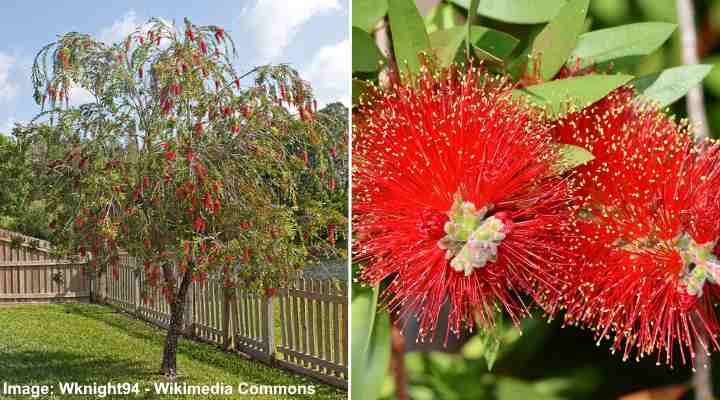
A crimson bottlebrush (Melaleuca citrina) tree and flowers
The lemon bottlebrush is a fast-growing evergreen shrub you can train as a flowering tree. It’s an ornamental plant with bright crimson bottlebrush flowers and lance-shaped leaves. The attractive features of the shrub-like small tree are its lemon-scented aromatic flowers and masses of cylindrical fuzzy bright-red flowers.
With a growth rate of up to 3 ft. (1 m) per year, the lemon bottlebrush has fast growth, reaching 25 to 30 ft. (7.6 – 9 m) tall. It thrives in full sun and well-drained soil. This drought-tolerant tree performs well as a hedge, foundation, or specimen plant. It is also suitable for coastal areas as it can withstand salty conditions.
- USDA Hardiness Zone: 10 and 11
- Sun Exposure: Full sun
- Growth Rate per Year: Up to 3 feet (1 meter)
- Mature Height: 3 to 25 feet (1 – 7.6 meters) tall and up to 20 feet (6 meters) wide
Monterey Cypress (Cupressus macrocarpa)
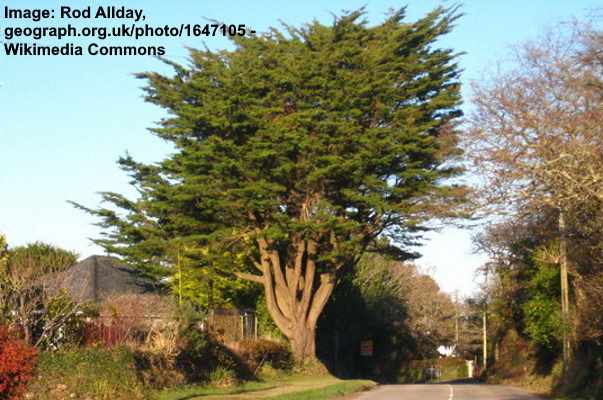
A Monterey cypress (Cupressus macrocarpa) tree
The Monterey cypress is a fast-growing evergreen tree characterized by its wide-spreading, irregular canopy. Native to California, the coniferous tree has pale reddish-brown bark, a dense, compact growth habit, and greenish-brown rounded cones. The conifer also has interesting, contorted branches, adding to its attractiveness.
Easy to grow in warm climates, the Monterey cypress grows up to 70 ft. (21 m) tall. It is ideal for planting in coastal regions as a specimen plant, tall hedge, or privacy screen. Additionally, its high wind tolerance makes it an ideal windbreak. The tree’s dense canopy also provides shade and shelter for wildlife.
- USDA Hardiness Zone: 7 to 11
- Sun Exposure: Full sun
- Growth Rate per Year: Rapid growth, up to 2 feet (0.6 meters)
- Mature Height: Between 40 to 70 feet (12 to 21 meters) tall and up to 80 feet (24 meters) wide
Florida Fiddlewood (Citharexylum spinosum)
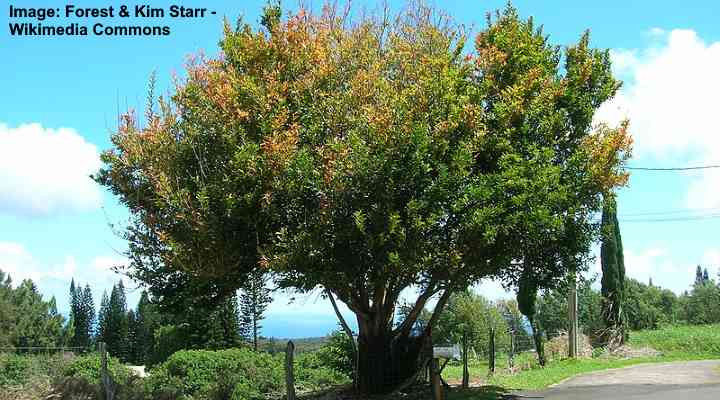
A Florida fiddlewood (Citharexylum spinosum) tree
The Florida fiddlewood grows rapidly at a rate of 2 ft. (0.6 m) per year until it reaches maturity at 35 ft. (10 m) tall. This native evergreen tree is recognized by its attractive, glossy, dark green leaves and fragrant clusters of trumpet-shaped white flowers. These are followed by fleshy orange berry-like drupes that ripen to black.
Florida fiddlewood trees thrive in full sun and well-drained soils and bloom throughout the year. The trees are drought-tolerant and withstand salt spray, making them suitable for coastal landscapes. The fragrant flowers attract hummingbirds, bees, butterflies, and other pollinators, making them a great addition to wildlife gardens.
- USDA Hardiness Zone: 9 to 11
- Sun Exposure: Partial shade
- Growth Rate per Year: 2 to 3 feet (0.6 to 1 meter)
- Mature Height: 15 to 35 feet (4.5 to 10 meters)
Virginia Pine (Pinus virginiana)
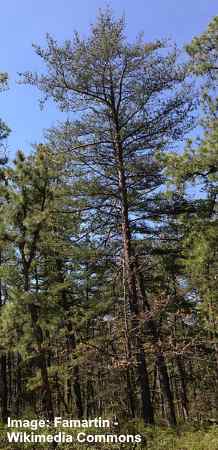
Virginia Pine (Pinus virginiana)
With a growth rate of over 1 ft. (0.3 m) per year, the Virginia pine is a fast-growing evergreen tree. Native to the southeastern United States, this conifer has a pyramidal shape, cinnamon brown bark, dark green needle leaves growing in bundles of two, and spiny-scaled cones.
Virginia pines grow up to 40 ft. (12 m) tall and are easily identified by their flat-topped crown. The tree’s irregular shape and evergreen foliage give it year-long interest in cold to temperate climates. Virginia pines are exceedingly cold-hardy and tolerate freezing temperatures, drought, and poor soil conditions.
- USDA Hardiness Zone: 3 to 7
- Sun Exposure: Full sun
- Growth Rate per Year: Fast growth, 1 to 2 feet (0.3 – 0.6 meters)
- Mature Height: 15 to 40 feet (4.5 to 12 meters)
Loblolly Pine (Pinus taeda)
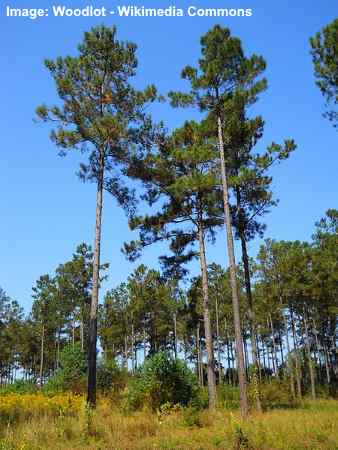
The tall Loblolly pines are very common in south-east USA
The loblolly pine is one of the fastest-growing pine trees, with a yearly growth of over 2 ft. (0.6 m). Growing up to 80 ft. (24 m), this impressive evergreen conifer has a rounded crown of needle-like leaves at the top of a tall, erect trunk. Additionally, the pine produces rust-brown slender cones 6” (15 cm) long.
This loblolly pine tree is known for its long, slender needles and large, woody cones. Native to the southeastern United States, the pine tree is suited to climates with hot, humid summers and mild winters. The attractive pine also attracts wildlife like songbirds and small mammals. It’s also the nesting habitat for the red-cockaded woodpecker.
- USDA Hardiness Zone: 6 to 9
- Sun Exposure: Full sun
- Growth Rate per Year: 2 to 3 feet (0.6 to 1 meter)
- Mature Height: 40 to 80 feet (12 – 24 meters) tall and up to 40 feet (12 meters) wide
Silver Wattle (Acacia dealbata)
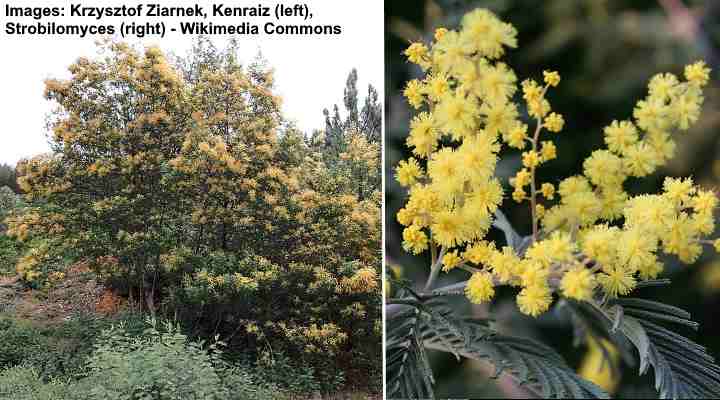
A silver wattle (Acacia dealbata) tree and flowers
The silver wattle is a fast-growing, small, evergreen tree with clouds of fluffy yellow flowers blooming in late winter and early spring. The leaves of silver wattle are finely divided, silver-gray or blue-green, creating feathery foliage. The hardy acacia tree has smooth, gray-green bark that fissures with age.
Silver wattle trees thrive in well-drained soils and full sun. They are ideal for tropical landscapes, adding year-long foliage and flowers to garden landscapes. The tree’s spreading roots make it a good choice for erosion control or to plant on slopes.
- USDA Hardiness Zone: 9 to 11
- Sun Exposure: Full sun
- Growth Rate per Year: Up to 3 feet (1 meter)
- Mature Height: 40 to 50 feet (12 to 15 meters) tall and wide
What Are the Fastest-Growing Trees?
Deciduous trees with the fastest growth are the hybrid poplar, weeping willow, and red maple. These rapidly growing trees can increase in height by 5 to 10 ft. (1.5 – 3 m) per year. The fastest-growing evergreen tree is the arborvitae cultivar ‘Green Giant,’ adding 3 ft. (1 m) to its height annually.
What are the Fastest Growing Trees for Shade?
Some of the fastest-growing trees for creating shade include the hybrid poplar (Populus deltoides x nigra) and the weeping willow (Salix babylonica) with its cascading branches. Additionally, the red maple (Acer rubrum) and the American sycamore (Platanus occidentalis) are also fast growing shade trees.
What are the Fastest Growing Trees for Privacy?
Evergreen trees are the best for screening a front or backyard. Many evergreens like thujas, the eastern white pine, red cedar, and Leyland cypress have dense evergreen foliage and upward columnar growth. These features make these trees ideal for privacy around your property. Additionally, their evergreen growth screens your yard during winter.
Why You Need Fast-Growing Trees?
Fast-growing trees are essential for quickly establishing privacy, windbreaks, and attractive landscapes. They offer cost-effective alternatives to fences and soften large spaces, enhancing property value and biodiversity. Whether for shielding neighbors’ views or creating an instant garden, these trees provide practical and aesthetic benefits for various landscaping needs.
How to Get the Quickest Growth From Fast Growing Trees
To achieve the quickest growth from fast-growing trees, focus on proper planting, watering, fertilizing, and pruning. Begin with meticulous soil preparation, enriching it with organic matter and ensuring proper spacing between trees. Consistent and adequate watering is crucial, adjusting frequency based on seasons. Deep watering encourages robust root development.
Fertilize your trees using slow-release or liquid fertilizers during the active growing season, with a focus on root development in the first year. Avoid over-fertilization and maintain a balanced nutrient supply.
Pruning plays a vital role in shaping trees for optimal growth. Prune in early spring to remove dead or crowded branches and promote a strong framework. Avoid excessive pruning to prevent tree stress.
Long-term care involves regular monitoring for pests and diseases. By following these steps, you can accelerate the growth of fast-growing trees and enjoy a lush, thriving landscape.
What is the Long-term Care for Fast Growing Trees?
Long-term care for fast-growing trees involves monitoring for pests and diseases, periodic pruning to maintain shape and health, and adjusting watering and fertilization as the trees mature. Regularly inspect the trees for signs of stress or infestations, and address issues promptly. Continue to provide adequate water and nutrients to support growth. Prune as needed in early spring to maintain structure and prevent overcrowding. Consistent care ensures these trees remain healthy and vibrant as they mature.
Related articles:
